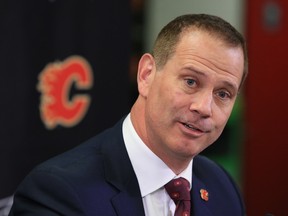
Article content
DJing is like building castles in the sand: you know that eventually your creation will be washed away by the tide.
Roster attrition is the natural situation for NHL decision makers. Whether due to injury, free agency, trades, budget constraints or aging, an NHL roster always faces inevitable changes.
Article content
Whether this is good or bad depends on your situation and perspective. Contending teams try to fight attrition as much as possible. Rebuilding teams depend on it to change their fortunes.
Advertisement 2
Article content
A transition phase like the one the Calgary Flames are entering is now marked by the acceleration of attrition due to two aggravating factors: the top part of the roster aging or fleeing into free agency and a pipeline of prospects that is not strong enough as to mitigate the loss.
In Calgary’s case, once they are traded (or flee as free agents), Noah Hanifin and Chris Tanev will join a list of recent ex-Flames that includes Nikita Zadorov, Elias Lindholm, Tyler Toffoli, Johnny Gaudreau, Sean Monahan and Matthew Tkachuk.
At the end of the 2025-26 season, Andrew Mangiapane, Yegor Sharangovich and Andrei Kuzmenko will become unrestricted free agents. Mikael Backlund, Jakob Markstorm and Rasmus Andersson will be UFAs in the summer of 2026.
Of the players listed, only Andersson (27), Kylington (26) and Sharangovich (25) are currently under 28 years old.
Nazem Kadri, the team’s top scorer, is 33 years old. Their top center, Mikael Backlund, will turn 35 in March, as will their starting goalkeeper, Jakob Markstrom, next January.
Age and free agency are about to decimate the top of a roster that is currently on track to miss the playoffs for the third time in four seasons.
Article content
Advertisement 3
Article content
Conversely, Calgary’s pipeline of prospects cannot sustain the roster through this level of loss. You can count on one hand the number of youngsters knocking on the door to play significant minutes: Connor Zary, Martin Pospisil, David Wolf, Jakob Pelletier and Matthew Coronato.
Calgary’s last three drafts are likely to produce just one addition to the main roster anytime soon (Coronato). None of the kids on the team currently emerge as future superstars.
Restructures occur when a GM needs to drastically restructure the supporting cast around a core of star players. Rebuilds occur when star players leave or erode, forcing the club to find new key pieces.
Brad Treliving’s brazen work in the 2022 offseason was perhaps the most drastic form of retooling possible, a sort of hybrid tactic situated between a retooling and a rebuild. He attempted to retain a core not by drawing and developing, but by transplanting a new core on the fly.
The additions of Kadri, Jonathan Huberdeau and MacKenzie Weegar following the departures of Gaudreau and Tkachuk were a bold attempt to open a window of contention that had seemingly slammed shut. The fact that it didn’t work illustrates how difficult and risky a core transplant can be.
Advertisement 4
Article content
However, there remains consternation in Calgary over what to call what Craig Conroy is currently orchestrating.
The word “rebuild” is never officially uttered by the Flames front office. Some segments of the fan base would prefer a restructuring to be the guiding spirit, given the number of good or very good players currently remaining on the roster (albeit temporarily).
But the truth is, it doesn’t matter what you call it. The reality of the situation will dictate the best course of action, not the corresponding nomenclature.
Conroy faces three tough factors as he prepares for the challenge ahead: the quality of the current roster construction (they are a bubble team), the pace of roster attrition (accelerated), and the net value of his pieces. key (decreasing with respect to time).
Recommended by Editorial
-

‘We will never give up’: Flames’ beliefs rise during winning streak
-

Calgary Flames defeat LA Kings and extend their winning streak
What this means is that the Flames aren’t good enough to endure major losses at the top of their depth chart and remain competitive, let alone become contenders. Your roster is also likely to erode faster than it can be replenished. And ultimately, the club’s asset base is trending toward a deficit, not a surplus.
Of the three factors, Conroy has the most control over the organization’s asset base as he positions himself to take advantage of expiring contracts over the next two to three seasons.
Roster quality and attrition are mostly built-in at this point, inexorable processes that will unfold over time. As ruthless as the tide.
The Flames’ sandcastle is tilting and will soon be torn down. Now is the time to start building something new.
Article content


